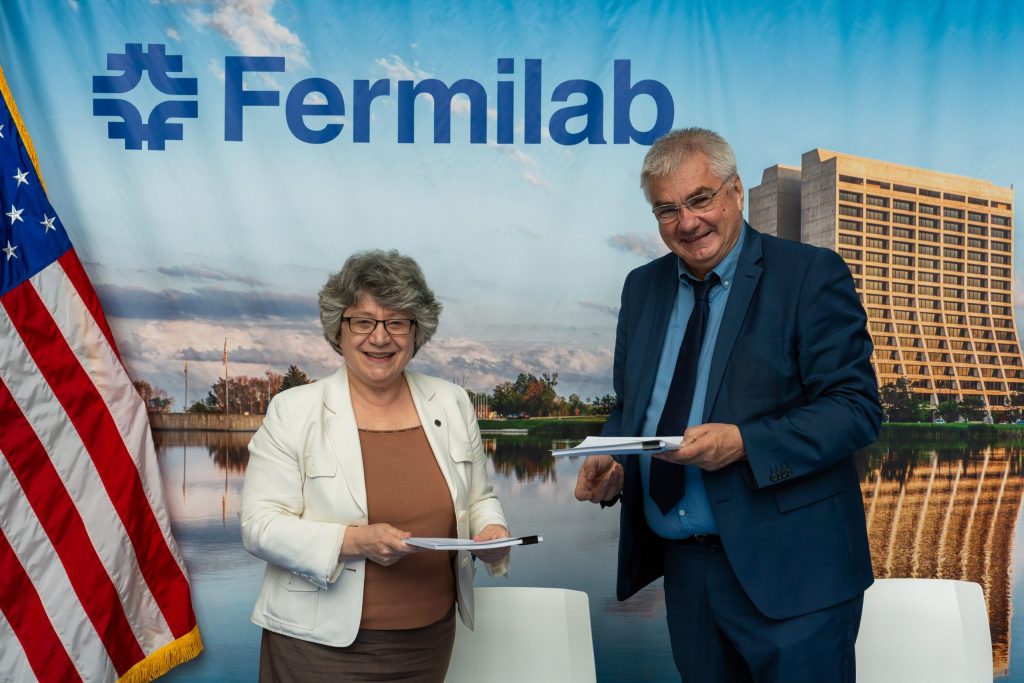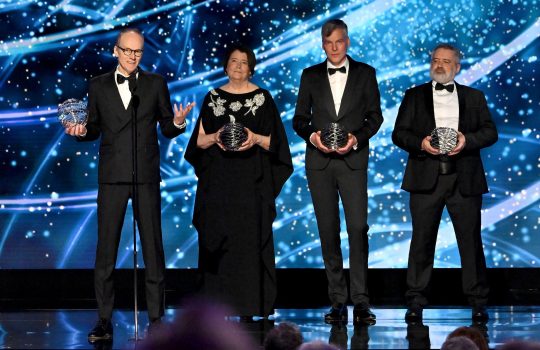Neutrinos are the most abundant matter particles in the universe. Lightweight and elusive, they may hold the key to answering some of the greatest mysteries in particle physics and astrophysics. But these fundamental particles rarely interact with other matter, making them extremely difficult to detect and study.
The international Deep Underground Neutrino Experiment, or DUNE, an experiment hosted by U.S. Department of Energy’s Fermi National Accelerator Laboratory, promises to crack wide open the field of neutrino physics. DUNE will be the most comprehensive neutrino experiment in the world when it starts receiving the world’s most powerful neutrino beam, provided by an upgraded particle accelerator complex at Fermilab.

Lia Merminga, director of Fermilab, and Joachim Mnich, CERN director for research and computing, signed a project planning document that details CERN’s contributions to the international Deep Underground Neutrino Experiment. Photo: Dan Svoboda, Fermilab
On Sept. 11, Fermilab and the European Organization for Nuclear Research, known as CERN, signed a project planning document to advance DUNE. This document follows two initial agreements signed in 2017 and 2021 in which CERN agreed to provide two large, approximately five-story-tall cryogenic vessels for the experiment. Each would house one of the DUNE particle detector modules planned for the experiment’s site in South Dakota, and each would be filled with 17,500 tons of liquid argon. The project planning document lays out the details of the equipment that CERN will provide, the quality standards it has to meet, and when it will be shipped to the United States.
Excavation of the large caverns of the Long-Baseline Neutrino Facility that will house the cryogenic vessels, detector modules and related infrastructure a mile underground in South Dakota is nearly 80% complete.
“The signing of the project planning document is an important milestone for the project at a timely moment,” said Joachim Mnich, CERN Director for Research and Computing, who signed the document on behalf of CERN. “The construction of components for the large cryostats — CERN’s contribution to the infrastructure of the project — is in full swing.”
DUNE will study neutrinos that are produced at Fermilab, outside Chicago, and then sent straight through earth and rock to Lead, South Dakota, 800 miles away. No tunnel is needed: Neutrinos’ ghostly nature, which makes them hard to catch with a particle detector, allows them to fly through normal matter unimpeded.
To study how neutrinos change along the way — a phenomenon known as neutrino oscillations — physicists will measure the neutrinos with a near detector hosted at Fermilab and huge far detectors in an underground laboratory at the Sanford Underground Research Facility in Lead. DUNE will also be able to detect neutrinos from astrophysical sources such as supernovas and will search for new subatomic phenomena such as proton decay.
DUNE is remarkable for its international character: More than 1,400 scientists and engineers from over 200 institutions in more than 35 countries, plus CERN, make up the DUNE collaboration. Collaborators are contributing expertise and resources to the design and construction of the experiment, providing economic benefits to partner institutions and countries.
“This is a historic moment for LBNF/DUNE. CERN is our largest international partner, and we are grateful for their contributions to this enormous particle physics experiment,” said Lia Merminga, Fermilab director. “We are looking forward to receiving the first components of the large cryogenic vessels next year. Then the installation can begin, bringing us one step closer to physics!”
Fermi National Accelerator Laboratory is supported by the Office of Science of the U.S. Department of Energy. The Office of Science is the single largest supporter of basic research in the physical sciences in the United States and is working to address some of the most pressing challenges of our time. For more information, please visit science.energy.gov.



